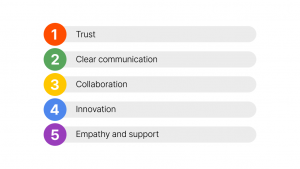Document editors are popular, and for good reason. Whether you’re creating your day-to-day documents, or memos and reports, you probably use a document editor in some capacity.
More than one million companies worldwide use Office 365, and they have Microsoft (MS) Word as their primary document editor. On the other hand, over five million paying businesses use G Suite, and they edit documents with Google Docs.
We have come a long way since then. Document editors have evolved from 1983’s MS Word 1.0, and we now have cloud-based editing tools such as Google Docs. But over time, certain limitations have come to light that cannot be solved by sticking to these platforms — the document editors are just not smart enough.
These document editing tools and many others have been around for quite some time. For example, MS Word was launched in 1983, at a time when both the internet and digital files were in their nascent stages.
Let’s have a look at why this is the case and what you can do about it.
The limitations of standard cloud-based document editors
Today, most information is delivered in digital format. Cloud-based document editors such as Google Docs have allowed many companies to stay on top of their digital file sharing, and some even offer features such as document management, file sharing, collaboration capabilities, and real-time notifications. These document editing tools work, but you could be doing so much more.
To illustrate this, here are some limitations of standard cloud-based document editors.
- No referencing capabilities. Your standard document editors like Google Docs have little to no features for referencing other documents. There’s no scope to create a database of resources that you can draw on to inform and contextualize your current document. This becomes a problem, especially when you’re collaborating with team members that you don’t frequently chat with. The collaborators can feel like they’ve been thrown into the deep end, with inconvenient top-down access to your document and its background.
- Limited collaboration. Although standard cloud-based document editing platforms have some collaboration capabilities, they tend to be more focused on the individual user rather than the entire team. This means they do a great job if you’re only looking for simple collaboration, but they may not be as effective once the entire team starts working on larger projects that require more robust project management. For example, you don’t have a mechanism to view task statuses and there are usually no progress tracking features.
- No built-in simultaneous viewing. A standard cloud-based editor doesn’t offer much in terms of inter-document layout. In most cases, you can only view one document at a time. Given that such an editor already has limited referencing abilities, referring to other documents gets a tad cumbersome.
- No intuitive way to connect files and folders. Most cloud storage platforms like Dropbox and Google Drive use the standard Folder >> Subfolder >> File approach. While the approach is simple at first glance, it can be tricky to understand how two files connect with each other. For instance, how do you show that a particular meeting note from one project is thematically linked to another meeting note from another project? With standard cloud-based document editors, the scope for laterally connecting documents is close to none, causing a very siloed organization system for startups that like to operate more fluidly.
All these limitations can have a huge impact on your organization’s efficiency and productivity. Thankfully there’s a smarter solution to cloud-based document editing, and it’s called Typed.
How to level up your document editing experience with Typed
Typed is a next-gen document editor, file collaboration tool, and knowledge management system that is built specifically for startups that need a ton of team effort and communication.
With Typed, you can enjoy many benefits that you would otherwise not get with the standard cloud-based document editors. You get to supercharge your document editing with many features:
- Smart, easy, and blazingly fast information collection. Typed is more than just a document editor. You can organize your documents in a way that makes sense to you, allowing you to retrieve them as quickly as possible. For example, you can organize documents by context instead of arbitrary folder-file pathways. Typed ensures that you always have the necessary context for a given document, enabling you to pick up where other team members left off seamlessly.
- Game-changing document referencing. Each Typed document allows you to add: 1) other documents as references, and 2) backlinks to other Google documents (even on mobile). You can create lateral links between documents (whether across projects or folders), and even save webpages as references.
- Highlights + Read Only Mode. These handy features allow you to filter out superfluous content and only focus on what’s important in a given reference. Don’t want to be distracted by buttons, menus, or images as you read through a webpage? Use read-only mode to only see the text on that page. Need to save a sentence for later? Highlight it and add it seamlessly to your reference library.
- Recommendations. How would you like your document editor to know which documents are important to you at a given moment? Typed suggests relevant documents depending on the file you’re currently working on, so you can access a related document easily without even having to look for it!
- Visualizing connections through network mode. Worried that the way different documents connect in your head won’t quite match the mental image your team has? With Typed, your entire team can access a shared pictorial representation of your documents.
The network mode presents a web of documents for everyone to reference — explaining not only where a document is precisely located, but what its parent documents are, how they relate to other documents, and how complex your project is getting, all in real-time.
- Built-in simultaneous viewing. Using the Typed split-screen feature, you can view two files simultaneously—the file you’re working on, and a file you’re using as reference.
- Push deadlines and tasks onto your Google calendar. Assigning tasks and setting deadlines is simpler with Typed. Once you’ve finished editing a document, you can assign it to another team member and set a deadline in Google calendar without leaving the Typed platform. No more manual deadline setting or switching to another platform to assign tasks.
Typed recognizes that document creation is only one part of the bigger picture — your team needs just as much support in collaborating, as well as organizing and managing the finished file with maximum efficiency.
A smarter editor for smarter work
An efficient document editor is a must-have for any organization, particularly one in the startup space. The last thing you need is a not-so-great editor that will add to the pile of work you already have to go through to make your company succeed.
A smart editor will have features that not only allow you to get the work done, but also boost your productivity and efficiency in the process. You’ll be able to edit, delegate, share, and manage all your documents in one place. Typed allows you to do all this and more. The knowledge management and collaboration tool turns scattered information into a knowledge network, turning disparate information channels into a single brain.
Sign up for free today and start working smart with Typed!



